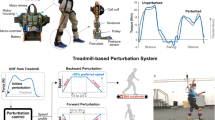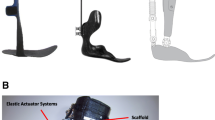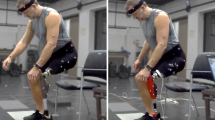Abstract
Background
Whole-body angular momentum (H) influences fall risk, is tightly regulated during walking, and is primarily controlled by muscle force generation. People with transtibial amputations using passive-elastic prostheses typically have greater H compared with nonamputees.
Questions/purposes
(1) Do people with unilateral transtibial amputations using passive-elastic prostheses have greater sagittal and frontal plane H ranges of motion during walking compared with nonamputees and compared with using powered prostheses? (2) Does use of powered ankle-foot prostheses result in equivalent H ranges in all planes of motion compared with nonamputees during walking as a result of normative prosthetic ankle power generation?
Methods
Eight patients with a unilateral transtibial amputation and eight nonamputees walked 0.75, 1.00, 1.25, 1.50, and 1.75 m/s while we measured kinematics and ground reaction forces. We calculated H for participants using their passive-elastic prosthesis and a powered ankle-foot prosthesis and for nonamputees at each speed.
Results
Patients using passive-elastic prostheses had 32% to 59% greater sagittal H ranges during the affected leg stance phase compared with nonamputees at 1.00 to 1.75 m/s (p < 0.05). Patients using passive-elastic prostheses had 5% and 9% greater sagittal H ranges compared with using powered prostheses at 1.25 and 1.50 m/s, respectively (p < 0.05). Participants using passive-elastic prostheses had 29% and 17% greater frontal H ranges at 0.75 and 1.50 m/s, respectively, compared with nonamputees (p < 0.05). Surprisingly, patients using powered prostheses had 26% to 50% greater sagittal H ranges during the affected leg stance phase compared with nonamputees at 1.00 to 1.75 m/s (p < 0.05). Patients using powered prostheses also had 26% greater frontal H range compared with nonamputees at 0.75 m/s (p < 0.05).
Conclusions
People with a transtibial amputation may more effectively regulate H at two specific walking speeds when using powered compared with passive-elastic prostheses.
Clinical Relevance
Our results support the hypothesis that an ankle-foot prosthesis capable of providing net positive work during the stance phase of walking reduces sagittal plane H; future studies are needed to validate our biomechanical findings with larger numbers of patients and should determine whether powered prostheses can decrease the risk of falls in patients with a transtibial amputation.





Similar content being viewed by others
References
Au SK, Herr HM. Powered ankle-foot prosthesis—the importance of series and parallel motor elasticity. IEEE Robotics & Automation Magazine. 2008;15:52–59.
Au SK, Weber J, Herr H. Powered ankle-foot prosthesis improves walking metabolic economy. IEEE Transactions on Robotics. 2009;25:51–66.
Bennett BC, Russell SD, Sheth P, Abel MF. Angular momentum of walking at different speeds. Hum Mov Sci. 2010;29:114–124.
Dempster P, Aitkens S. A new air displacement method for the determination of human-body composition. Med Sci Sports Exerc. 1995;27:1692–1697.
Eilenberg MF, Geyer H, Herr H. Control of a powered ankle-foot prosthesis based on a neuromuscular model. IEEE Trans Neural Syst Rehabil Eng. 2010;18:164–173.
Elftman H. The function of the arms in walking. Hum Biol. 1939;11:529–535.
Herr H, Popovic M. Angular momentum in human walking. Journal of Experimental Biology. 2008;211:467–481.
Herr HM, Grabowski AM. Bionic ankle-foot prosthesis normalizes walking gait for persons with leg amputation. Proc Biol Sci. 2012;279:457–464.
Kadaba MP, Ramakrishnan HK, Wootten ME. Measurement of lower-extremity kinematics during level walking. J Orthop Res. 1990;8:383–392.
Kadaba MP, Ramakrishnan HK, Wootten ME, Gainey J, Gorton G, Cochran GVB. Repeatability of kinematics, kinetics, and electromyographic data in normal adult gait. J Orthop Res. 1989;7:849–860.
Kulkarni J, Toole C, Hirons R, Wright S, Morris J. Falls in patients with lower limb amputations: prevalence and contributing factors. Physiotherapy. 1996;82:130–136.
Lenth RV. Java Applets for Power and Sample Size [computer software] Available at: http://www.stat.uiowa.edu/~rlenth/Power. Accessed August 12, 2013.
Markowitz J, Krishnaswamy P, Eilenberg MF, Endo K, Barnhart C, Herr H. Speed adaptation in a powered transtibial prosthesis controlled with a neuromuscular model. Philos Trans R Soc B Biol Sci. 2011;366:1621–1631.
Miller WC, Speechley M, Deathe B. The prevalence and risk factors of falling and fear of falling among lower extremity amputees. Arch Phys Med Rehabil. 2001;82:1031–1037.
Neptune RR, McGowan CP. Muscle contributions to whole-body sagittal plane angular momentum during walking. J Biomech. 2011;44:6–12.
Palmer ML. Sagittal plane characterization of normal human ankle function across a range of walking speeds. Cambridge, MA, USA: Mechanical Engineering, Massachusetts Institute of Technology; 2002. Available at: http://dspace.mit.edu/bitstream/handle/1721.1/16802/50504711.pdf. Accessed April 10, 2014.
Pijnappels M, Bobbert MF, van Dieen JH. Contribution of the support limb in control of angular momentum after tripping. J Biomech. 2004;37:1811–1818.
Pijnappels M, Bobbert MF, van Dieen JH. Push-off reactions in recovery after tripping discriminate young subjects, older non-falters and older fallers. Gait Posture. 2005;21:388–394.
Silverman AK, Fey NP, Portillo A, Walden JG, Bosker G, Neptune RR. Compensatory mechanisms in below-knee amputee gait in response to increasing steady-state walking speeds. Gait Posture. 2008;28:602–609.
Silverman AK, Neptune RR. Differences in whole-body angular momentum between below-knee amputees and non-amputees across walking speeds. J Biomech. 2011;44:379–385.
Silverman AK, Wilken JM, Sinitski EH, Neptune RR. Whole-body angular momentum in incline and decline walking. J Biomech. 2012;45:965–971.
Simoneau GG, Krebs DE. Whole-body momentum during gait: a preliminary study of non-fallers and frequent fallers. J Appl Biomech. 2000;16:1–13.
Winter DA. Biomechanical motor patterns in normal walking. J Motor Behav. 1983;15:302–330.
Winter DA. Biomechanics and Motor Control of Human Movement. New York, NY, USA: Wiley; 1990.
Zmitrewicz RJ, Neptune RR, Sasaki K. Mechanical energetic contributions from individual muscles and elastic prosthetic feet during symmetric unilateral transtibial amputee walking: a theoretical study. J Biomech. 2007;40:1824–1831.
Acknowledgments
We thank BiOM for providing prostheses and technical assistance.
Author information
Authors and Affiliations
Corresponding author
Additional information
One of the authors (AMG) received a Career Development Award from the Department of Veterans Affairs RR&D Service to support this research. This study was sponsored by Providence VAMC Center for Restorative and Regenerative Medicine (VA RR&D A3962R).
All ICMJE Conflict of Interest Forms for authors and Clinical Orthopaedics and Related Research ® editors and board members are on file with the publication and can be viewed on request.
Clinical Orthopaedics and Related Research ® neither advocates nor endorses the use of any treatment, drug, or device. Readers are encouraged to always seek additional information, including FDA-approval status, of any drug or device prior to clinical use.
Each author certifies that his or her institution approved the human protocol for this investigation, and that all investigations were conducted in conformity with ethical principles of research, and that informed consent for participation in the study was obtained.
This work was performed at the Gait and Motion Analysis Laboratory of the VA Medical Center, Center for Restorative and Regenerative Medicine, Providence, RI, USA.
About this article
Cite this article
D’Andrea, S., Wilhelm, N., Silverman, A.K. et al. Does Use of a Powered Ankle-foot Prosthesis Restore Whole-body Angular Momentum During Walking at Different Speeds?. Clin Orthop Relat Res 472, 3044–3054 (2014). https://doi.org/10.1007/s11999-014-3647-1
Published:
Issue Date:
DOI: https://doi.org/10.1007/s11999-014-3647-1




